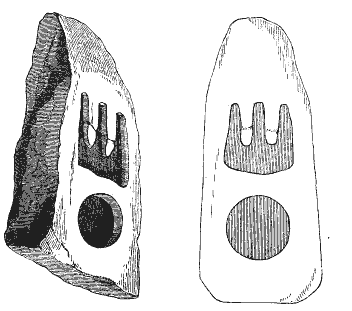
BY THE REV. E. L. BARNWELL.
IN the Temporary Museum at Douglas, during the Meeting of the Association in the Isle of Man last year, there was exhibited a stone mould, of which an accurate representation is here given from the pencil of Mr. Blight. The stone is at King William's College. In the catalogue of the Museum it was said to be a mould for casting combs; but it is doubtful if combs of such a form have ever been discovered,— at any rate such a three-pronged article seems ill adapted for such a purpose. The earliest combs in wood or bone are of very different form: in fact, they are almost the same as those in use at the present day. Men sufficiently advanced so as to practise the art of casting metal would hardly have adopted such a form if they wanted a comb. It may, therefore, be safely as sumed that the article in question is nothing of the kind. It is, however, not so easy to say what it is, and what its use. It bears, indeed, a faint resemblance to the bronze implement lately found in Anglesey, and described in a late number of the Archaeologia Cambrensis by Mr. Albert Way. That implement, which is very similar to one found in Edinburgh, and noticed in the Proceedings of the Scottish Antiquaries, is supposed to have been a kind of razor. Similar articles have also been found in Ireland; but none of these is of the same form as the one under consideration,. which could not, from the narrow space between the prongs, admit of the finger and thumb, by which the razors were thought to have been held.

The circular mould also presents another difficulty; for it is not easy to guess at its intended use, and whether the disc of cast metal was in any way connected with the three-pronged instrument. The presence, however, of the two moulds on one block seems to shew that these may have had some connexion.
The larger of the two implements may, however, have served as a veritable fork, which may have been fitted with a double handle; but in this case one would have expected that it would have been provided with a tang or shaft of some kind; or it may have been a kind of scraper, although this suggestion is worth little. It is possible that similar articles may exist in some collection, by a comparison of which some light may be thrown on what at present seems to be a puzzle.
|
|
||
|
|
||
|
Any comments, errors or omissions
gratefully received The
Editor |
||